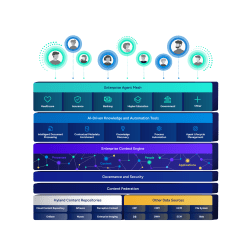Benefits
Ease the burden of bringing valuable new information into the enterprise with intelligently automated capture tools.

Harness the power of a unified content, process and application intelligence platform to unlock the value of enterprise content.
Learn more
Automate your document-centric processes with AI-powered document capture, separation, classification, extraction and enrichment.
Learn about Hyland IDPIt's your unique digital evolution … but you don't have to face it alone. We understand the landscape of your industry and the unique needs of the people you serve.
 Overview of industries
Overview of industries
Countless teams and departments have transformed the way they work in accounting, HR, legal and more with Hyland solutions.
 Overview of departments
Overview of departments
We are committed to helping you maximize your technology investment so you can best serve your customers.
 Overview of services
Overview of services

Discover why Hyland is trusted by thousands of organizations worldwide.
Hear from our customers
Our exclusive partner programs combine our strengths with yours to create better experiences through content services.
Overview of partners
Find resources to power your organization's digital transformation.
Browse the resource center
Hyland connects your content and systems so you can forge stronger connections with the people who matter most.
Learn about HylandWith our modern, open and cloud-native platforms, you can build strong connections and keep evolving.
 Dig deeper
Dig deeper
Automate the intake of information like emails, invoices, transcripts and more into business systems, and kick-off processes with accurate, up-to-date data.

Quick and accurate content onboarding is a critical prerequisite to many vital business processes. Hyland’s industry-leading AI-powered document processing technology significantly boosts process efficiency and performance.
Ease the burden of bringing valuable new information into the enterprise with intelligently automated capture tools.
Automate the capture and processing of information to speed up workflows and decisions.
Dramatically reduce the direct and indirect costs of processes with automation and AI-powered tools.
Eliminate bottlenecks, reduce exceptions and bypass manual processes with automated capture and processing.
Automation paired with AI make data capture and extraction processes more consistent and accurate, leading to fewer errors.
AI-enabled OCR engines accurately identify information in scanned documents or image files to enable document classification and data extraction.
Scanned or imported documents are automatically categorized by document types, and packets of multiple documents are automatically separated into individual documents for further processing.
AI-powered processing engines locate and extract relevant data from scanned or imported documents and can even validate extracted data against other systems.
Applying gen AI to the intake process can provide new insights, such as autogenerated document summaries, analyses and informed predictions.
Extracted or imported data is automatically sent to the relevant systems and workflows, freeing staff from manual copying and pasting.
Web-based interface with low-code design studio makes automation design, deployment and management easy and accessible.
— Ninja Kobor, Solution Owner, Siemens

Explore expert coverage of Hyland from the world’s most trusted and respected analyst firms.

Infosource recognizes Hyland as a market-leading Star vendor in the Capture & IDP space.

Automation can make a major positive impact for an organization. Explore how the automation landscape is shaping up as AI and more connective content management products evolve.

Review new data from industry analyst and Intelligent Business Strategies CEO Mike Ferguson about how AI and content intelligence can maximize your business value.
We have received your message and will be in contact shortly.
We have received your message and will be in contact shortly.
